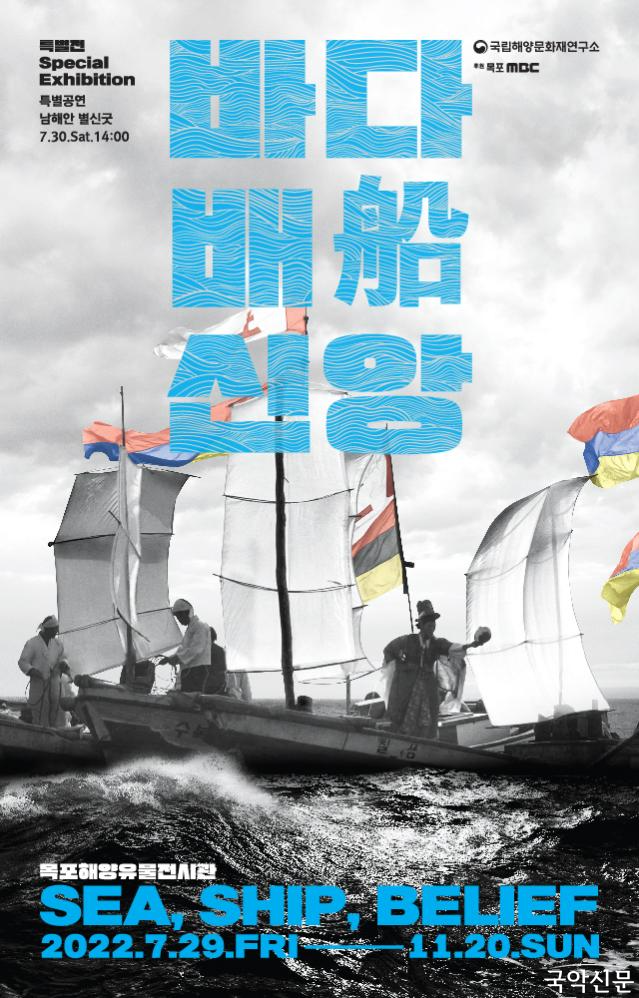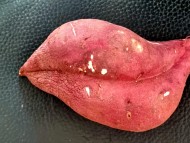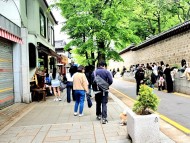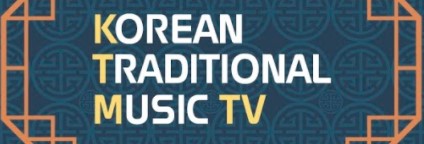2024.05.03 (금)
The National Research Institute of Maritime Cultural Heritage presents its special exhibition
- Michael Lammbra…
- 등록 2022.07.28 02:57
- 조회수 6,111

The National Research Institute of Maritime Cultural Heritage (Lee Kyu Hoon, Director's representative) presents its special exhibition of 2022 entitled 'Sea, Ship, Beliefs' at the Mokpo Maritime Museum from July 29 to November 20 to mark the 3rd Island Day.
Korea is a peninsula surrounded by water on three sides; hence, various maritime beliefs have been passing down along coastal regions. This exhibition reveals the stories of the people who adapt themselves to sea and make lives with the sea. Traditional religious beliefs and practices protect fishermen’s lives in an ever-changing sea, where abundance and disaster coexist. The National Research Institute of Maritime Cultural Heritage hopes this exhibition enables visitors to explore the lives of the fishermen who sublimated the desire for an abundant catch of fish and safety at sea into community festivals.
The first theme is 'Ships, Crossing over the Sea of Life and Fear'. Ships are vital to people who depend on seas, rivers or lakes for their way of life and their live -lihoods. While the art of boat building and sailing skills have continuously advanced, dangers faced by the fishermen are unavoidable. Varieties of boat rituals and worship of the boat guardian deities are therefore performed by fishing communities in Korea.
The second theme is 'Sea God, Worshiped as a Guardian Deity of Nation and the People'. Since ancient time, people believed that deities who rule earth, sea, and sky. Celestial god and water god, in particular, are worshiped not only for well-being of individual and community, but also for peace in the royal family, national defense, and navigational safety. Sea god rituals were held not only by the state, but also by local officials and civilians to express gratitude for the favors of spiritual beings.
The third theme is 'Fishermen, Praying for Safety and a Big Catch'. Wishing for an abundant catch and safe navigation, fishermen worshiped deities. Maritime rituals refer to a number of rites held in the coastal regions, such as sea, island, docks and seaside. Dangje of the west coast, pungeoje and byeolsije of the eastern and southern coasts are typical communal rites. Pungeoje(ritual for big catch) was a ceremonial process to summon aid from various sea gods, aiming at encouraging a bounteous catch and ensuring a safe return to harbours.
The fourth theme is 'Boats, Guiding Souls from Sea to Heaven'. In Korean Shamanism, a death ritual is held to app-ease both the living and the dead. In shamanic rites, the boat as a symbol was treated as a vehicle to transport individuals to the Otherworld with confidence and comfort. During shamanic death ceremonies, shamans either went directly to the sea by boat or floated a miniature of straw ship on the beach, and prayed for the spirit of the dead to leave this world and safely move to heaven.
The National Research Institute of Maritime Cultural Heritage hopes that the exhibition entitled "Sea, Ship and Belief” will deepen visitors’ understanding of the way of life of fishermen in the past. The rituals preserved in fishing villages across Korea were developed by fishing communities over a long period of time as an integral part of their way of life, in which abundance coexisted with fear. The traditional sea belief believed that individuals and their entire community, and humans, nature and local deities all assisted each other in ensuring their safety and prosperity, and consequently developed rituals that reflected their worship. The National Research Institute of Maritime Cultural Heritage expects that this exhibition will contribute to restoring the traditional rituals of Korean fishing communities and preserving them for future generations as a crucial element of the marine folk cultural heritage.
- [] 제6회 울진금강송 전국국악경연대회(06/08)
- [] 제29회 대통령상 한밭국악전국대회(07/06-07) (무용/기악/성악)
- [] 제8회 목담 최승희 전국국악경연대회(06/01) (판소리,기악)
- [] [서울]제28회 전국판소리경연대회(06/15-16)
- [] 제32회 대전전국국악경연대회(06/01-02)
- [] 제16회 순천 낙안읍성 전국가야금병창경연대회(05/25-26)
- [] 제18회증평국악경연대회(05/11)
- [] [군산]제32회 전국청소년민속예술경연대회(05/18)
- [] 제42회 전주대사습놀이 학생전국대회(5/18∼6/2)
- [] 제50회 전주대사습놀이 전국대회(5/18~6/3)
- [] 제20회 전국대금경연대회(06/08-09)
- [] 제4회 함양 전국국악경연대회(05/12)
- [] 제18회 대한민국 전통예술무용·연희대제전(06/09)<br>무용(전통무용…
- [] 제48회 부산동래 전국전통예술경연대회(06/15-16)(무용.기악)
- [] [부여]제1회충남전국청소년국악경연대회(05/04)(판소리.기악.타악)
- [] [광주]제21회 대한민국 가야금병창대제전(06/16)
- [] 제18회 과천전국경기소리경창대회(05/04)
- [] 제11회 곡성 통일전국종합예술대전(06/15-16)(판소리.무용, 기악,…
- [] 제24회 인천국악대제전 전국국악경연대회(05/25-26)
- [] 제26회 창원야철전국국악대전(07/06- 07)
- [] 2024 무안장애인 승달국악대제전(06/01-02)
- [] 제22회 무안전국승달국악대제전(06/01-02)
- [] 제10회 전국공주아리랑민요경창대회(05/26)
- [] 제17회 상주전국국악경연대회(05/19)(성악/무용·연희/기악)
- [] 제10회 전국밀양아리랑경창대회(05/26)
- [] 제21회 강남전국국악경연대회(05/22)(무용/타악/판소리/민요)
- [] 제26회 서편제보성소리축제 전국판소리 고수 경연대회(05/04-05)
- [] [순천]제10회 낙안읍성 전국 국악대전(04/27-28)
- [] 제29회 안산전국청소년국악경연대회(05/26)
- [] 제26회(통합58회) 여수진남전국국악경연대회(05/18-19)
- [] 제51회 대한민국 춘향국악대전 경연대회(05/05)(05/11-12)
- [] 제33회 고령전국우륵가야금경연대회(04/26-27)
- [] [부평]제8회 전국 청소년국악경연대회(05/11)(관악/현악/성악)
- [] 제22회 구례전국가야금경연대회(05/04-05)
- [완도]제24회 장보고국악대전 전국경연대회(05/05-06)(무용/판소리…
- [] 제23회 대한민국 빛고을 기악대제전(05/25-26)
- [] [인천] 제10회 계양산국악제(04/26-27) (풍물,사물, 기악,민요…
-

[수요연재] 한글서예로 읽는 우리음악 사설(191)<br>원주아리랑
원주아리랑을 쓰다. 한얼이종선 (2024, 한지에 먹, 40× 63cm) 아침에 만나면 오라버니요 밤중에 만나면 정든 님 일세...
-

[금요연재] 도자의 여로 (143) <BR> 백자철화편병편과 수물(受物)편
같은 백자가마터 출토품이라는 것도 이규진(편고재 주인) 편병은 병을 만든 후 앞과 뒤를 누르거나 두드려 면을 만든 그릇이다. 조선 전기부터 후기까지 지속적으로 만든 기...
-

[국악신문] 정창관의 ‘국악-신반’ <21>
윤하림 해금풍류 II 산조 윤하림 해금풍류 II 산조. (2024년 Sound Press 음반번호없음) 2023년 윤하림 ...
-

[국악신문 소장자료] (42)아리랑 최초 취입 아리랑, ‘1913년 京城卵卵打令’
일본 니포노폰 취입 조선민요 ‘경성란란타령’, 1913년 Nipponophone 6170 SP음반.(국악신문 소장자료) ...
-

[Pick리뷰] 경성 모던걸들의 춤판 '모던정동'…"자유 갈망하는 모습 담아"
30일 서울 중구 국립정동극장에서 열린 국립정동극장예술단 정기공연 '모던정동' 프레스콜에서 출연진이 주요 장면을 시연하고 있다. 2024.4.30 ...
-

세실풍류, 박병천의 '구음시나위'에 허튼춤 선사한 안덕기
국립정동극장이 4월 한달간 진행하는 '세실풍류 : 법고창신, 근현대춤 100년의 여정'에서 23일 박병천의 '구음시나위'에 허튼춤 추는 안덕기 (사진=국립정...
-

세실풍류, 동해별신굿 민속춤사위를 제해석한 조재혁의 '현~'
국립정동극장이 4월 한달간 진행하는 '세실풍류 : 법고창신, 근현대춤 100년의 여정' 에서 조재혁의 '현~' 공연 모습. (사진=국립정동극장). 2024....
-

[Pick리뷰] 이호연의 경기소리 숨, ‘절창 정선아리랑!’
# ‘이호연의 경기소리 숨’ 공연이 지난 4월 26일 삼성동 민속극장 ‘풍류’에서 열렸다. 20대에서 60대까지의 제자들 20명과 5명의 반주자와 함께 경기잡가, 경기민요, 강원도...
-

[PICK인터뷰] 미리 만나 보는 '제94회 남원춘향대전'
[국악신문 정수현 전문기자]=대한민국에서 가장 오래된 축제로 손꼽히는 남원춘향대전(남원춘향제)이 오는 5월 10일(금)부터 5월 16일(목)까지 7일간 남원시 광한루원 일대에서 열...
-

[Pick리뷰] 모던연희극 ‘新칠우쟁론기’
4월 18일부터 20일, 남산국악당에서 아트플랫폼 동화의 모던연희극 ‘新칠우쟁론기’가 펼쳐졌다. [국악신문 정수현 전문기자]=지...
-

[PICK인터뷰] 국립국악관현악단의 채치성 예술감독을 만나다
[국악신문 정수현 전문기자]=봄비가 촉촉이 땅을 적시는 4월, 국립국악관현악단 예술감독으로 취임한 지 6개월이 된 채치성 예술감독님을 만났다. 그는 국악방송 사장, KBS 국악관현...
-

[Pick리뷰] 이 시대의 새로운 춘향가- ‘틂:Lost&Found’
2024 쿼드초이스_틂 (사진=서울문화재단 대학로극장 쿼드 나승열) [국악신문 정수현 전문기자]=대학로극장 쿼드의 ‘쿼드초이스’...
-

[Pick리뷰] 세 악단의 조화로운 하모니, ‘하나 되어’
지난 4일, 국립국악원은 국립국악원 창작악단, KBS국악관현악단, 전북특별자치도립국악원 관현악단 118명으로 구성된 연합 관현악단 무대 ‘하나되어’를 국...
-

[인터뷰] 김경혜의 '시간의 얼굴' 작품전, 16일 개막
칠순을 넘어서는 길목에서 중견작가 김경혜(영남이공대 명예교수) 작가의 열번째 작품전이 오는 16일부터 25일까지 10일간 대구시 중구 슈바빙 갤러리에서 열린다.전시되는총 50여 개...






























